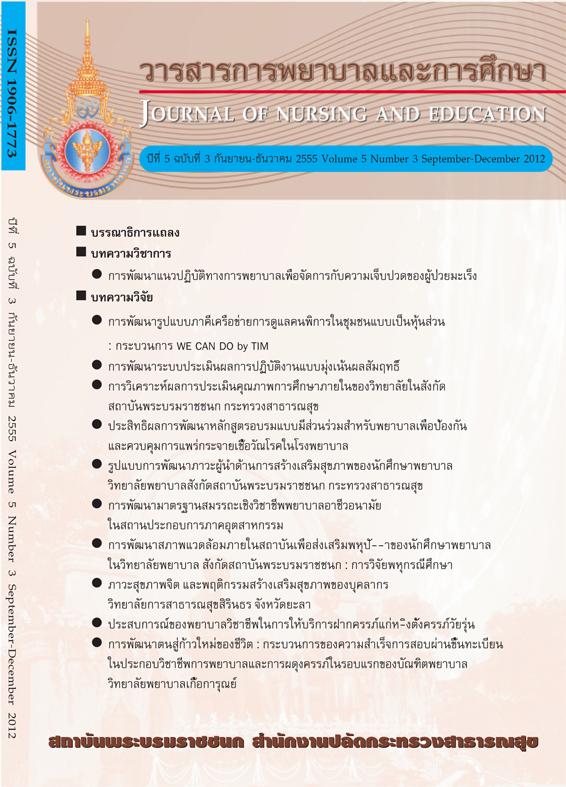การพัฒนาแนวปฏิบัติทางการพยาบาลเพื่อจัดการกับความเจ็บปวดของผู้ป่วยมะเร็ง
คำสำคัญ:
Development, Clinical Nursing Practice Guideline, Pain Management, Cancer Patientบทคัดย่อ
บทคัดย่อ
มะเร็งเป็นโรคเรื้อรังที่เป็นสาเหตุสำคัญของการเสียชีวิตของคนไทย เมื่อเข้าสู่ระยะท้ายส่วนใหญ่ จะมีอาการปวดและนำมาซึ่งความทุกข์ทรมาน การศึกษาครั้งนี้มีวัตถุประสงค์เพื่อพัฒนาแนวปฏิบัติ ทางการพยาบาลเพื่อจัดการกับความเจ็บปวดในผู้ป่วยมะเร็ง โรงพยาบาลเชียงรายประชานุเคราะห์ โดย ประยุกต์ตามแนวทางการพัฒนาแนวปฏิบัติของศูนย์ความรู้เชิงประจักษ์ทางการพยาบาลและผดุงครรภ์
แห่งประเทศไทย คณะพยาบาลศาสตร์ มหาวิทยาลัย เชียงใหม่ กลุ่มตัวอย่างเป็นผู้ป่วยมะเร็งระบบทางเดิน อาหารจำนวน 60 ราย มีคุณสมบัติตามเกณฑ์ที่กำหนดไว้ กลุ่มทดลองมีจำนวน 30 ราย ได้รับการพยาบาล ตามแนวปฏิบัติทางการพยาบาล กลุ่มควบคุมมีจำนวน 30 ราย ได้รับการพยาบาลตามปกติและเก็บข้อมูล ย้อนหลัง ในการศึกษาความพึงพอใจของพยาบาลต่อการใช้แนวปฏิบัติทางการพยาบาล ประชากรคือ พยาบาลซึ่งใช้แนวปฏิบัติทางการพยาบาล จำนวน 20 คน เครื่องมือที่ใช้ในการวิจัยประกอบด้วย 1.แนวปฏิบัติ ทางการพยาบาล เนื้อหาประกอบด้วย 1) การประเมินอาการปวด 2) การบรรเทาอาการปวด โดยการใช้ยา และไม่ใช้ยา 3) การดูแลด้านจิตสังคม 4) การให้คำแนะนำแก่ผู้ป่วยและครอบครัว 2.มาตรวัดระดับ ความเจ็บปวด 3.แบบสอบถามความพึงพอใจของผู้ป่วย 4.แบบสอบถามความพึงพอใจของพยาบาล เครื่องมือทั้งหมดผ่านการตรวจสอบความตรงด้านเนื้อหา (Content validity) ได้ค่า CVI = .98 ผลการทดลอง ใช้เพื่อทดสอบความเป็นไปได้ในการปฏิบัติ (pilot study) กับผู้ป่วยมะเร็งระบบทางเดินอาหาร 5 ราย พบว่าไม่มีปัญหาเกี่ยวกับเนื้อหาและขั้นตอนการปฏิบัติ ก่อนทดลองใช้ได้ประเมินคุณภาพของการพัฒนา อีกครั้งโดยแบบประเมิน AGREE ของ St.George’s Hospital Medical School, London 2 แปลโดยฉวีวรรณ ธงชัย ผลการประเมินเท่ากับร้อยละ 99.28 วิเคราะห์ข้อมูลโดยวิเคราะห์ค่าที (Dependent t-test and
independent t-test)
ผลการศึกษาพบว่า คะแนนความเจ็บปวดของผู้ป่วยมะเร็งระบบทางเดินอาหารหลังใช้แนวปฏิบัติ ทาง การพยาบาลมีค่าลดลงกว่าก่อนการใช้อย่างมีนัยสำคัญทางสถิติ (=2.27 และ = 3.77, t = 5.55, p <.001) คะแนนความเจ็บปวดหลังการทดลองของกลุ่มทดลองต่ำกว่ากลุ่มควบคุมอย่างมีนัยสำคัญทางสถิติ (=2.27 และ = 3.30, t = 3.17, p <.01) ส่วนความพึงพอใจของผู้ป่วยและพยาบาลต่อการใช้แนวปฏิบัติ ทางการพยาบาล อยู่ในระดับมาก (=3.91 และ 3.92 ตามลำดับ)
จากผลการศึกษามีข้อเสนอแนะว่า แนวปฏิบัติทางการพยาบาลเพื่อจัดการกับความเจ็บปวด ของผู้ป่วยมะเร็งสามารถนำไปใช้กับผู้ป่วยมะเร็งระบบทางเดินอาหารได้อย่างประสิทธิภาพ และควรมี การปรับปรุงแนวปฏิบัติการพยาบาล นี้ตามงานวิจัยใหม่ที่เพิ่มขึ้นและบูรณาการแนวปฏิบัติการพยาบาล นี้เข้าไว้เป็นส่วนหนึ่งของการพัฒนาคุณภาพ อย่างต่อเนื่องเพื่อพัฒนาคุณภาพการพยาบาลต่อไป
คำสำคัญ : การพัฒนา แนวปฏิบัติทางการพยาบาล ความเจ็บปวด ผู้ป่วยมะเร็ง
Abstract
Cancer is a chronic disease which is one of the important causes of death in Thailand. Pain is a common problem found in the cancer patient with the end of life. The objective of this study was to develop pain management clinical nursing practice guideline in the cancer patient. The Thailand Centre for Evidence-based Nursing and Midwifery Model was used as a framework of the study. The experimental group (n=30) received Cancer pain management guideline while the data from the control group (n=30) who received conventional nursing care was collected retrospectively. Furthermore, the nurses who
provided this guideline for the experimental group were also included in this study. The research
instruments were Cancer pain management guideline, Pain scale, Patient satisfaction scale, and Nurse satisfaction scale. The Cancer pain management guideline themes included 1) pain assessment 2)
pharmacological and non-pharmacological management 3) psychosocial care 4) health education for the patients and their families. All instruments were content validated. The clinical nursing practice guideline was also refined concerning the experts’ suggestions as well as public hearing. It was tested in five cancer patients at the Inpatient department of Chiangrai regional hospital as a pilot project. Finally, the
quasi–experimental research aimed to determine the effects of the clinical nursing practice guideline among patients with gastrointestinal tract cancer was established. Dependent and independent t-tests were used for data analysis.
The result revealed that the experimental group had statistically significantly lower pain score after receiving Cancer pain management than that of before receiving (=2.27 and = 3.77, t = 5.55, p<.001). Additionally, the experimental group had statistically significantly lower pain score than that of the control group (=2.27 and = 3.30, t = 3.17, p<.01). Furthermore, patient satisfaction and nurse satisfaction were reported as good. (=3.91 and 3.92, respectively).
The study indicated that the Cancer pain management guideline can be used in patients with
gastrointestinal tract cancer in order to effectively relieve cancer pain. Thus, the guideline should be
improved in response to new research evidence and integrated as a part of Continuous Quality
Improvement (CQI ) in order to improve the quality of nursing care.
Keywords: Development, Clinical Nursing Practice Guideline, Pain Management, Cancer Patient






